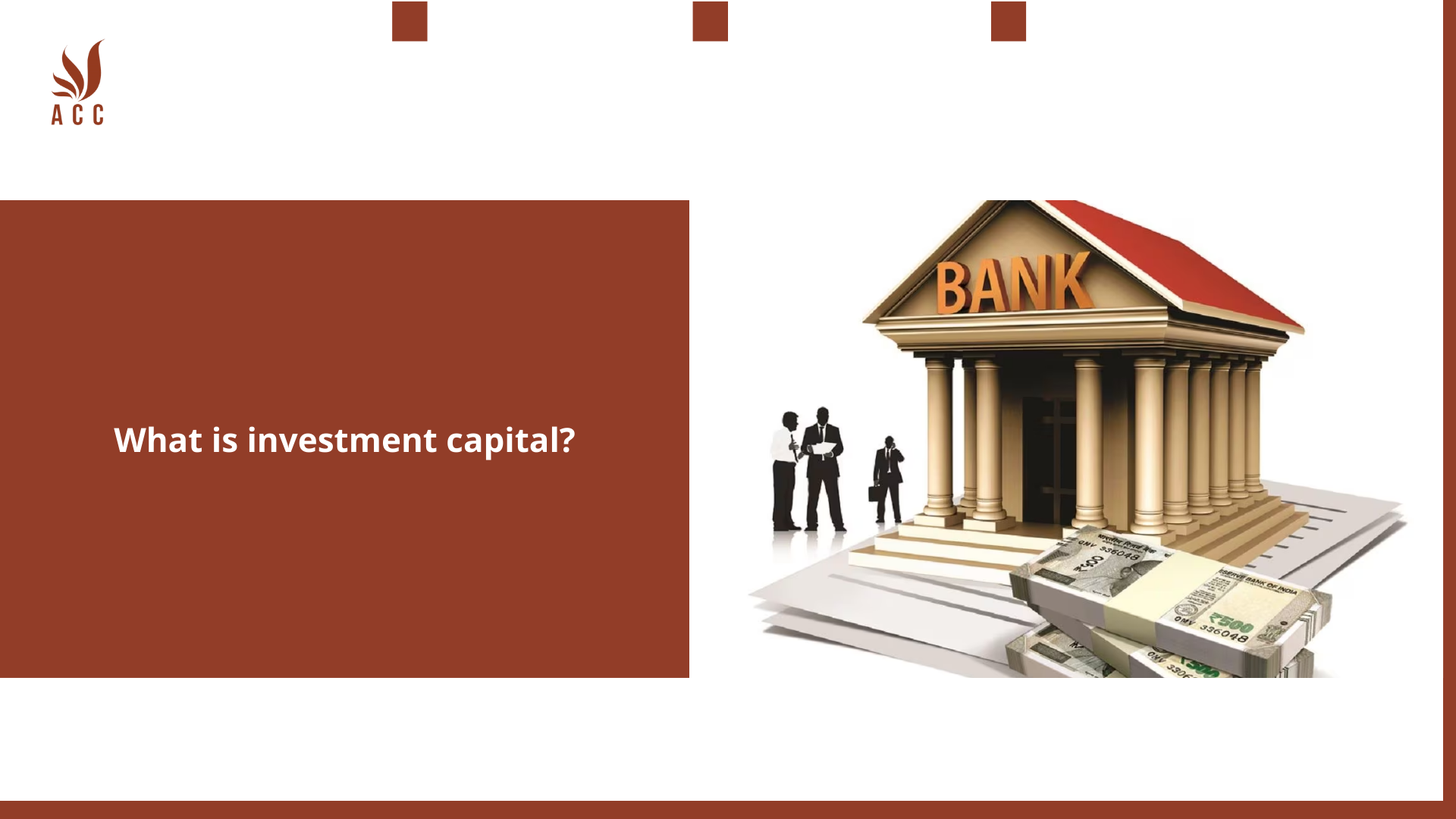
In the dynamic world of business, capital investment plays a pivotal role in shaping the future of companies. It's a term that encompasses a broad range of financial activities, from acquiring physical assets to injecting funds for long-term growth. This article delves into the realm of capital investment, breaking down its intricacies, strategies, and exploring the advantages and disadvantages it offers.
1. What Is Capital Investment?
Capital investment is the acquisition of physical assets by a company for use in furthering its long-term business goals and objectives. Real estate, manufacturing plants, and machinery are among the assets that are purchased as capital investments. These investments are a testament to a company's commitment to its future and its readiness to embrace growth opportunities.
2. How Capital Investment Works
Capital investment is a multifaceted concept, which can be defined in two distinct ways:
-
Financial Capital Investment: In this context, an individual, a venture capital group, or a financial institution provides funding to a business, either as a loan or a share of future profits. It's about infusing the business with the necessary cash to fuel expansion and innovation.
-
Physical Capital Investment: Here, the company's executives take the reins, investing in long-term assets such as equipment to enhance efficiency and stimulate growth. This approach involves acquiring tangible assets that act as pillars for the company's future endeavors.
Both forms of capital investment are essential, and they serve as catalysts for a company's journey toward sustainable growth.
In today's diverse business landscape, securing capital investment can come from various sources. Start-ups may seek funding from venture capital firms or angel investors, while established companies may use their cash reserves or seek loans from traditional financial institutions. Going public is another avenue for acquiring substantial capital investment from a multitude of investors.
3. Capital Investments for Business
A strategic decision to make a capital investment is at the heart of a company's long-term growth plans. These investments aim to increase operational capacity, capture a larger market share, and generate higher revenue. A company might also invest in other businesses that complement its operations, thereby expanding its reach and influence.
For capital-intensive businesses, the need for specific assets is paramount. For instance, an oil-drilling company relies on heavy machinery to extract raw materials for processing, which starkly contrasts with the low capital investment needs of a law firm.
Businesses also need to consider the strategic aspects when opting for capital investments. For instance, they should weigh the advantages of incurring a capital investment as opposed to recurring rental expenses. Leasing heavy machinery might provide short-term cost benefits, but capital investments can often yield better long-term results.
4. Types of Capital Investments
Capital investments are diverse, reflecting the multifaceted nature of business growth. Some common types of capital investments include:
- Land: Companies may acquire undeveloped land for future expansion.
- Buildings: Purchasing existing structures for manufacturing, storage, or headquarter operations.
- Assets Under Development: Companies may assemble assets over time, such as constructing a new building, which is considered a capital investment.
- Furniture and Fixtures: Although more temporary, certain aspects of furniture and fixtures can overlap with capital investments.
- Machinery: Investments in production equipment to improve manufacturing processes.
- Software Development or Computing Devices: Capital investments in software development are increasingly common and can be capitalized and amortized over time.
The choice of capital investment type depends on a company's goals, market dynamics, and budget considerations.
5. Advantages and Disadvantages of Capital Investments
Pros of Capital Investments
Capital investments offer numerous advantages, which can vary depending on the specific situation:
- Enhanced Productivity: New equipment and technology investments improve efficiency, reduce costs, and increase output, thereby bolstering productivity.
- Cost Savings: Investments can lead to long-term cost savings. For instance, energy-efficient equipment can lower utility bills, and streamlined processes may reduce manual labor requirements.
- Competitive Advantage: Capital investments can set a company apart from competitors. They create barriers to entry and help maintain market dominance.
- Quality Improvement: Investments often lead to higher-quality goods, satisfying customers and boosting brand reputation.
Cons of Capital Investments
While capital investments bring remarkable benefits, they come with some downsides:
- Short-term Earnings Impact: Capital investments tend to reduce short-term earnings growth, which might disappoint stockholders.
- Risk and Commitment: Committing to long-term investments carries financial and legal commitments, tying up cash and reducing financial flexibility.
- Operating Costs: Certain capital investments, like land acquisition, may involve ongoing operating expenses, such as property tax assessments.
- Dilution and Debt: Financing capital investments through issuing additional stock or taking on debt can dilute shareholder value or increase debt burdens, which are closely monitored by stakeholders and analysts.
6. Accounting for Capital Investments
Proper accounting for capital investments is crucial to maintain financial transparency and adherence to financial regulations. The accounting process involves:
- Recording the Asset Cost: This includes the purchase price of the asset and any additional costs like installation and transportation.
- Capitalization: Assets that meet the company's capitalization policy are recorded as capital assets on the balance sheet. This allows spreading the asset cost over its useful life.
- Depreciation: Depreciation methods are used to allocate the asset cost over time. Various methods, such as straight-line and declining balance, may be employed.
- Impairments: In case of losses, impairments are recorded to reduce the value of the capital investment.
- Disposal: Companies follow specific procedures when disposing of capital investments.
7. Example of Capital Investment
To put things into perspective, let's consider a real-world example. Amazon, a global e-commerce giant, reported a net asset balance of $186.7 billion for property and equipment on its year-end financial statements in 2022. These capital investments, excluding land, are depreciated and reported as their cost minus accumulated depreciation. Such figures are classified as noncurrent assets on the balance sheet due to their long-term nature.
8. What Is an Example of a Capital Investment?
One classic example of a capital investment is when a company purchases land. This acquisition is typically a capital investment due to the substantial capital required for such a long-term, illiquid asset.
9. How Does a Capital Investment Work?
A capital investment operates on the premise of long-term value. Companies make significant upfront payments to acquire assets that will yield benefits over an extended period. This approach contrasts with short-term expenses, as capital investments are intended to provide superior long-term value compared to recurring costs incurred within a single accounting period.
10. The Largest Downside to a Capital Investment
The primary downside to a capital investment is the commitment it entails. Companies may need to make a substantial long-term financial and legal commitment when purchasing capital assets. This ties up their cash, limits flexibility, and poses a risk that the investment may not yield the expected results. Unlike smaller purchases, capital investments are strategic endeavors, and their success is not guaranteed.
In conclusion, capital investment is the cornerstone of long-term business growth, underpinning companies' pursuit of success and innovation. While it offers immense benefits, the decision to invest in capital assets must be made judiciously, considering the company's financial situation, market dynamics, and long-term goals. It's a strategic choice that can shape a company's destiny and establish its position in the competitive business landscape.
11. Why should professionals use ACC Law Firm's capital Service?
-
Expertise in Legal Matters: ACC Law Firm specializes in legal services, providing professionals with access to experienced attorneys who can offer valuable legal guidance. Whether it's contract negotiations, intellectual property issues, employment matters, or any other legal concern, their expertise can be invaluable.
-
Tailored Legal Solutions: ACC Law Firm understands that every professional's needs are unique. They can customize their legal services to address the specific challenges and opportunities faced by professionals in different fields.
-
Risk Mitigation: Legal issues can pose significant risks to professionals and their businesses. ACC Law Firm can help identify and mitigate these risks, reducing the potential for costly legal disputes or compliance issues.
-
Resource Optimization: Professionals can save time and resources by outsourcing their legal needs to ACC Law Firm. This allows them to focus on their core competencies and business objectives, while leaving legal matters in the hands of professionals.
-
Access to a Network: ACC Law Firm may have a network of legal experts and professionals in various fields, which can be beneficial for clients seeking connections and advice beyond just legal services.
Q&A
Question 1: What is investment capital?
Answer 1: Investment capital refers to the financial resources that individuals, organizations, or entities allocate for the purpose of acquiring assets, securities, or investments with the expectation of generating a return or profit over time.
Question 2: How does investment capital differ from working capital?
Answer 2: Investment capital is distinct from working capital. Working capital is the money a business uses for its day-to-day operational expenses and short-term liabilities, while investment capital is specifically designated for longer-term investments, such as stocks, real estate, or bonds.
Question 3: What are the main types of investment capital?
Answer 3: The main types of investment capital include:
-
Equity Capital: This involves buying ownership shares in a company, such as stocks or ownership stakes in a partnership or LLC.
-
Debt Capital: This consists of investments in loans or bonds, where the investor lends money to an entity in exchange for periodic interest payments and the return of the principal amount at maturity.
-
Real Estate Investments: Investment capital can be used to acquire real estate properties, which can generate rental income and appreciate in value.
-
Start-up and Venture Capital: Investors provide capital to start-up companies in exchange for equity, with the hope of profiting from the company's growth.
Question 4: What are the key factors that influence investment capital decisions?
Answer 4: Several factors influence investment capital decisions, including the investor's risk tolerance, investment goals, time horizon, market conditions, economic factors, and the specific asset or investment class being considered. Additionally, regulatory and tax considerations may also play a significant role in investment capital decisions.
Nội dung bài viết:






Bình luận